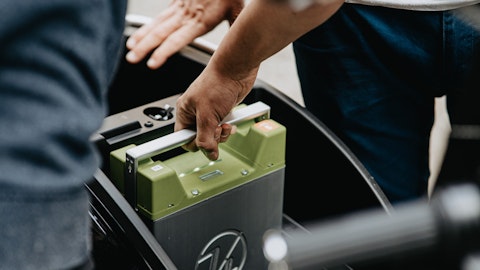Steve Girsky: Battery supply is still tight-winning. We’re doing what we can, we want to support both launches basically, and we deal with that internally. So we try and get as much fuel cell trucks out there as we can, but we also have, we’re going to be, we’re going to put it this way. We’re going to be battling that all year, which is why we push this out into next year when we could put our own trucks back in the market. If things change, they change and we’ll update you as they change and we’ll see where they go, but it’s really a supply constraint issue on batteries right now.
Thomas Okray: And Winnie, that really speaks to the difficulty in giving firm guidance on specific metrics going forward, because one of the things we really want to do with this call is reset it to really make sure that when we say something, we’re going to do it. But hopefully, you can appreciate all the moving parts. Starting up a new dealer network with a new technology, getting suppliers on board and ramping up, managing a recall, trying to get the allocation between BEV and fuel cell, working with the government entities to make sure we’ve got efficient disbursement of voucher money and are in line appropriately for other government funding. There’s just a lot of moving parts right now, which makes it very challenging to call the ball and pinpoint some of the future guidance items.
Steve Girsky: Yes, it’s a real Rubik’s cube is what we’re trying to solve here, right. And on one hand, we’re trying to get these beds back. On the other hand, we’re building an ecosystem around hydrogen. We had more trucks in the quarter. We had new customers, we had repeat customers. We had new regions. This ecosystem is developing, and as it develops, we get more interest. And the flywheel that Tom talked about earlier is keeps moving and it starts to move faster. But one thing that’s clear has not changed is we are so committed to the zero emissions mission and firmly believe that the hydrogen vehicle is key for long haul trucking. I mean, we can’t be serious as a nation to say that we want to have zero emissions and not do something with long haul trucking. And we’re first out there. We’re pioneers here. There’s a lot of moving parts, but we’re going to build that order book, get the flywheel going, and then watch people jump on.
Winnie Dong: That’s very helpful. Thank you very much.
Operator: Our next question is from Jeff Kaufman with Vertical Research Partners. Please proceed.
Jeffrey Kauffman: Thank you very much. Hey, and congratulations, and welcome to Tom as well.
Thomas Okray: Hey, Jeff. Thank you.
Jeffrey Kauffman: Fair amount of my questions have been answered, so I just want to hone in on what I would consider to be kind of transitory items. So things like we had to go back and repurchase trucks, or we had to write down $20 million of inventory and things like that. If I look at the first quarter and I sum up all those kind of unusual costs, how much of that is unique the first quarter, how much of this is going to drag on the second? So what I mean is, you sold 40 trucks at $380,000 should have been 15 million in revenue. You reported seven because you had to repurchase some back. And then there were some other costs that I’m assuming were buried in cost of goods sold. Regarding inventory and things like that. Can you help me understand what was more unique to first quarter versus things that are going to continue forward?
Steve Girsky: Yes, that’s a great question. And there is a lot of unique things. I wouldn’t say it’s so much first quarter. I would say it’s, again, to repeat, until we build the scale. I mean, one of the things that you didn’t talk about was warranty. We’re working with our supplier partners to get the experience out there so we can do an appropriate warranty accrual. Right now, our warranty number is way outsized and there’s no way it’s going to be like that going forward. But we just don’t have enough miles and enough trucks out there to be able to reduce it credibly. So that’s one thing. The net realizable value where we write down inventory, that’s another thing that is not going to continue. Obviously, that’s a point in time.
The returning, the BEV vehicles, which hits is another one. We also had an FFI transaction in there which hit SG&A, which is in total about 18.3 million, to be exact. So you’re absolutely right, and thank you for bringing it up. There’s a lot of stuff out there that, we haven’t called out as one-time items, but we don’t expect them to continue once we get the flywheel going.
Jeffrey Kauffman: Okay. And then, I see that you have increased the fueling station location outlook, but no real increase in volume for this year. So, just kind of, I understand this is flywheel related, but help me understand, if we’re increasing the locations that are available, shouldn’t we be seeing a similar increase potentially in units wholesale?
Steve Girsky: Yes, so I’ll take that. Remember, we’re juggling three balls, right? We’ve got customers, we’ve got trucks, and we’ve got fuel. And at any one time, one of those balls is ahead and one of those balls is behind, well, fuel has been behind. And we’re trying to move fuel from instead of being a quarter or two behind, to being a quarter or two ahead. Not too far ahead, because we don’t want stranded capital out there, but we need it to be ahead. So, we are dropping more fueling locations in place. This is based on feedback from our sales team and from customers. And then, you’ll see the sales follow up as we get trucks, by the way. So, we’re managing supply constraints, we’re managing fuel constraints, and that’s limiting our customer growth. And as Tom mentioned earlier, we’re doing everything we can to remove these constraints. So, that’s why we’re trying to get ahead.
Thomas Okray: And I mean, just to throw on and amplify a little more, going to these big national accounts, you’ve got to have the fuel in place, or else that discussion doesn’t go as smoothly as you would want to.
Jeffrey Kauffman: No, that makes sense. Thank you. And then one last question. So, as we focus a little more on national accounts, as you mentioned, there are a lot of incentives out there for customers, particularly in California ports. And you’ve got some FOMOs, so you’re seeing better incentives in other states. Is the headline ASP really as big an issue with all these incentives, or would it be for national and fleets? The ASP initiates the conversation, and then we’ll figure out the incentives down the road.





